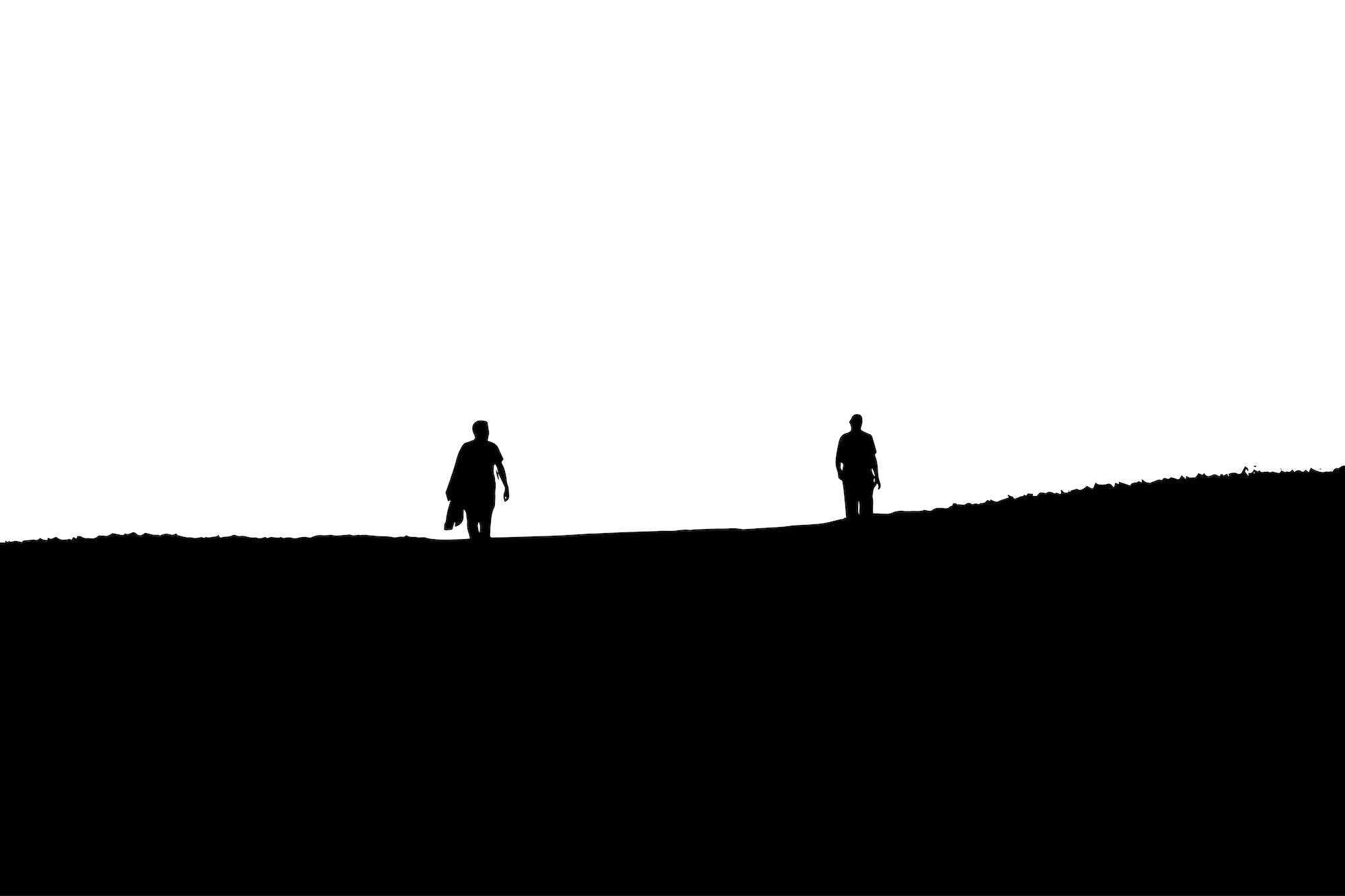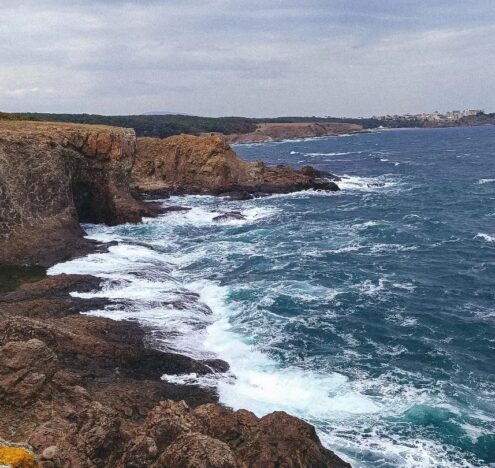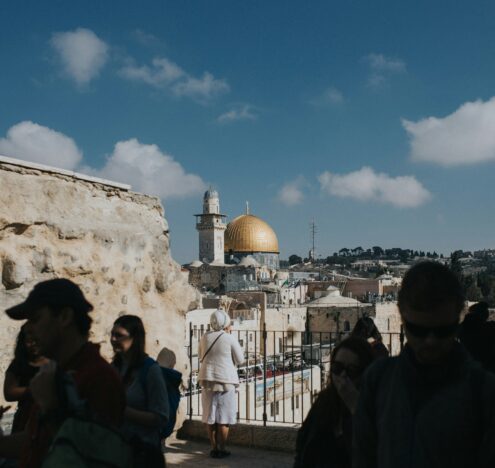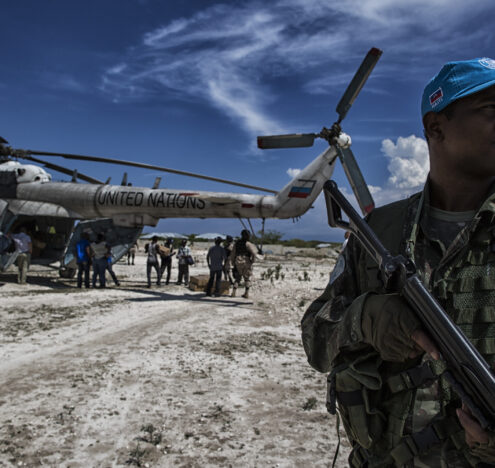In a courtroom in Kigali, Rwanda, a trial reminiscent of the latest Hollywood movie, “The Mauritanian” is underway. Like the Guantanamo inmate profiled in the new Jodie Foster and Tahar Rahim film, the man on trial has been kidnapped on one continent and flown to another, where he stands accused of terrorism. Unlike “The Mauritanian,” the man on trial, Paul Rusesabagina, is a US resident and a Belgian national of Rwandan origin, famous for his role in saving over 1,000 Rwandans from the 1994 genocide in his native country. His acts of heroism, profiled in the Academy Award winning film “Hotel Rwanda,” earned him the Presidential Medal of Freedom from George Bush in 2005.
How someone revered as a hero internationally, and at least for a time by some in his native country, now stands on trial for terrorism related charges is a story particular to the complicated politics of Rwanda and another Paul, its longtime leader, Paul Kagame. The kidnapping of one Paul (Rusesabagina) by the government of the other Paul (Kagame) brings into stark contrast the clash of the multiple narratives of the country of Rwanda. The conflicting yet intertwining stories of Rwanda’s two most famous citizens have become emblematic of the clash of the country’s larger narratives and the challenges of healing, repair, reconciliation and good governance that will determine its future.
Each Paul’s competing narratives for Rwanda share common elements but also diverge spectacularly. One is the story of development success built in the aftermath of one of the twentieth century’s worst crimes, the Rwandan Genocide, and highlights unprecedented steps taken to unite the country’s ethnically diverse population into a single people. The other offers a far more complex narrative of a country whose record of laudable social and economic progress is paired with a dark underside of horrific human rights abuses and military aggression resulting in the death, displacement and suffering of hundreds of thousands of people across the African Great Lakes region.
The conflicting yet intertwining stories of Rwanda’s two most famous citizens have become emblematic of the clash of the country’s larger narratives and the challenges of healing, repair, reconciliation and good governance that will determine its future.
The personal narratives of the two men are no less striking – each possessing dueling versions. Paul Kagame, effective ruler of Rwanda for the last 17 years, is seen by some as a visionary reformer and liberator of his native land, and by others as an authoritarian despot whose contributions to the betterment of Rwandans are fundamentally marred by the criminal behavior of his regime, endangering the future he purports to want for its people. Just as confounding are the narratives about Paul Rusesabagina, who for many is a humble man who rose to levels of moral courage that few achieve but to his detractors is a charlatan who parlayed an unremarkable, and even questionable, role in one of the world’s great tragedies into a self-aggrandizing stint as a global celebrity.
At their core, however, the dueling personal narratives of these two men are reflections of the contested history of Rwanda over the last 30 years. It is a history still being written. Its import belies the country’s small size and is rooted in our world’s need to understand and prevent any future act of genocide, and the sense of collective responsibility felt by many leaders and nations for failing to intervene in Rwanda’s Genocide, as well as prevent the deadly consequences of what has been called Africa’s First World War in the Democratic Republic of Congo. Understanding that history in all of its complexity is essential to assessing the seductive but problematic example that Rwanda’s development successes present to the world and the lingering question of how efforts at reconciliation can contribute to sustained peace in the region.
DEVELOPMENT TRIUMPH AND HUMAN RIGHTS CATASTROPHE
Rwanda and its leadership have presented a conundrum to the country’s friends and followers for some time. Since the 1994 genocide, under the leadership of Paul Kagame, the country has been heralded for its development successes, reducing child mortality from a high of 276 per thousand at the end of the genocide to only 34 per thousand in 2019, increasing life expectancy from 27.7 years at the end of the genocide to 68.7 years in 2018, while growing GDP per capita 600% since the Genocide. The country has become the “development darling,” attracting significant flows of public and private aid dollars and foreign direct investment. Kigali is often described as the Singapore of Africa, the cleanest city on the continent, and proponents of the government are quick to tout that the country hosts the first plant to manufacture cell phones entirely made in Africa.
But the successes and the plaudits that Rwanda has justly earned do not tell the whole story, as Paul Rusesabagina and other Rwandan exiles and close observers of the country point out, often at significant personal risk. Kagame has essentially ruled the country since 1994. In 2015, he engineered a constitutional referendum allowing him to serve two more 7-year terms, effectively allowing him to stay in power until 2034. His election victories have been landslides but marked by media repression and a stifling of free speech. Opposition figures, including many disaffected insiders from his own government, have been jailed and silenced, and dozens have been disappeared or killed, both in Rwanda and internationally.
The kidnapping and the illegal rendition of Paul Rusesabagina in September of this past year is just the latest and most public example of the willingness of Rwanda’s government to flout international law to secure its own power. In an even more consequential series of illegal and norm breaking actions, Rwanda has played a destabilizing role for the last 20 years in the Democratic Republic of Congo (DRC). Shortly after the Rwanda Genocide, its army invaded the eastern DRC during the two Congo Wars lasting until 2002, conflicts whose death toll estimates are as high as 3 million. A 2002 agreement to remove Rwandan forces from the DRC didn’t hold and since then Rwanda has continued to sponsor brutal armed groups, violating a number of international sanctions regimes. The ongoing turmoil in the region has been called one of the world’s largest humanitarian crises. In 2018, UNHCR reported that the DRC was home to over 500,000 refugees and 4.5 million displaced people.
The tragedy in the DRC is the result of many forces and factors, not just the actions of Rwanda, but Kagame’s government has long played and continues to play a destabilizing role. Though Rwanda’s government regularly denies its army is operating in the Eastern Congo, numerous bodies from the UN to Western intelligence agencies have found to the contrary in reports issued as recently as last year.
Rwandan nationals, who defend their government’s action, accuse critics of not understanding the challenges of governing a country in the wake of the Genocide and the strategic complexities of the African Great Lakes region. They emphasize the country’s remarkable progress to better the conditions of its people and build a country where ethnicity is not a cleavage to be exploited by unscrupulous leaders. The government for its part deflects all criticism and both Kagame and his intelligence chiefs have joked, threatened and even bragged about their willingness to track down and kill opponents.
A TIME FOR SCRUTINY
Paul Kagame and his government’s systematic violations of human rights have in essence received a “pass” by governments, businesses and aid agencies, not only in Rwanda, but across Africa and our globe. Why? One answer is surely the desire to herald and support the remarkable social and economic progress that the country has achieved for its citizens. Additionally, many may be loath to question a country whose horrific and tragic experience of genocide is so recent, and which has undertaken multiple efforts to address the crimes and promote healing while pursuing policies to forge a national identity that transcends ethnicity. Another explanation offered by Rwandan opposition figures, exiles and observers alike is the belief by many, whether fully articulated or not, that Kagame and his party, the Rwanda Patriotic Front (RPF), are the saviors in the horrific story of the Rwandan Genocide. So, as they rebuild their country in a challenging neighborhood, we should cut them some slack.
Paul Kagame and his government’s systematic violations of human rights have in essence received a “pass” by governments, businesses and aid agencies, not only in Rwanda, but across Africa and our globe.
These rationales have been used for much of the past two decades to ignore or even excuse the worst aspects of the Rwandan government’s behavior. However, in recent years, they have finally come under necessary scrutiny. Multiple investigations between 2015 and 2019 have raised questions about the Rwandan government’s use of statistics to bolster its narrative of development success. Among the most serious of these allegations are that in the lead-up to the referendum granting Paul Kagame the ability to serve two more 7 year terms, data related to the country’s reduction of poverty were manipulated to show a continuous decline in poverty, despite the likelihood the poverty was actually increasing over a three year period from 2011 to 2014. While the findings of statistical manipulation in these investigations were disputed in official statements by the World Bank (one of Rwanda’s most important donors) and the Rwanda National Institute of Statistics Rwanda (NISR), leaked documents from both the World Bank and former consultants to the Rwandan government show widespread concern about the inflated claims of success.
The acknowledgement and deep concern over the manipulation of statistics by Rwandan government agencies does not negate all the visible progress that Rwanda has achieved for its citizens, especially in the area of public health. Indeed, for much of the last decade, there have been periodic reports in the US media along the lines of “What the US can learn from Rwandan healthcare” – stories that are grounded in real accomplishments. However, this particular set of alleged manipulations came at a critical time: a period of regime consolidation and the extension of one party’s power into the foreseeable future. That a government is so willing to manipulate statistics to secure its own hold on the institutions of power, and then eliminate and silence its opponents for decades, suggests we should all exercise extra caution in accepting its pronouncements.
A POTENTIAL PATH TO RECONCILIATION
Scholars and journalists have already begun to provide a fuller and more critical account of Rwanda’s efforts to promote a single unifying national identity and repair the harms of the Genocide. The country’s leadership has aimed to eliminate ethnic divisions and foster a single sense of Rwandan identity through a series of government policies and programs, going so far in 2004 as to outlaw all references to ethnicity, including making it a crime to even mention ethnicity in public discourse. While some recent research indicates that the government’s efforts at reducing the salience of ethnic identity appear to be having some impact, the same research cautions that there is no evidence to suggest that notions of ethnicity will not resurface in the future. And despite the government’s efforts to diminish all ethnic identity, there remains a perception that Tutsi elites predominate not just within government, but also among business and NGO’s.
The continuing power of ethnicity to shape behavior post-Genocide can be seen in Rwanda’s experience implementing a nationwide transitional justice process through 12,000 Gacaca courts. These were an indigenous system of community-based courts set up to address crimes of genocide, promote ownership of guilt by perpetrators, provide space for offering forgiveness and facilitate reconciliation. The Gacaca process lasted 10 years from 2002 to 2012, tried over 1,000,000 individual Hutu, and involved over 250,000 volunteer judges (most Hutu themselves). A 2015 study of these courts found that while they did make positive contributions by helping secure local peace, the structure of the Gacaca process created incentives for participation in order to gain favor with the new ruling elites, becoming, whether intentional or not, a tool of patronage, effectively bolstering the new government’s legitimacy and reinforcing feelings of disadvantage by Hutu. Particularly in their early years, the Gacaca courts were perceived as bringing about some degree of recognition of crimes and the promotion of healing and reconciliation in local communities. Over time, however, the courts were seen as morphing into a process that no longer focused on the specific crimes of the Genocide but increasingly a vehicle for contemporary score-settling over property disputes and other non-Genocide related crimes.
THE INCOMPLETE STORY OF TRUTH TELLING AND GENOCIDE
Perhaps the most significant shift away from the narrative promoted by the Rwandan government relates to the Genocide itself. Over a quarter of a century after the Genocide, an expanding body of data-driven scholarship is coming to revise and add nuance to our understanding of who was killed, how many and where these killings took place. This new body of scholarship requires us to look again at what has been popularly accepted, the figure of 1 million Tutsi’s who were brutally murdered, a figure that has been incorporated into the Preamble of Rwanda’s Constitution. This is not done to diminish the horrors of the Genocide perpetrated against Rwanda’s Tutsi minority, but to add to what we know of the violence both before, during and after the Genocide that impacted the lives of hundreds of thousands of people of Tutsi, Hutu and Twa descent.
This important new scholarship was featured prominently in a special section of the Journal of Genocide Research this past year, titled “Calculating Mortality in the Rwandan Genocide.” In seven different essays, scholars weighed in on the questions surrounding this challenging topic, carefully reviewing data sources, including using computational and quantitative social science methodologies, and addressing the many non- scientific factors that may be driving changing estimates of how many died and who they were. While the diverse authors are careful to note that precise number may never be known, each posits that actual deaths are most likely in the range of 500,000 to 600,000. In one of the two framing essays for the series, the author concludes that the official Rwandan government “body count” is “a ‘bad number’ that has masqueraded as science for too long.”
Two other significant points are made by researchers that carry implications for how we should view the Rwandan government, particularly its stated interest in truth-telling and reconciliation. The first is the difficulty in estimating how many Hutus were also killed during this period, given the Rwandan government’s neglect, and in some cases cover-up, of investigations of Hutu victims. The second is the devastating toll of other types of violence associated with the Genocide and its aftermath, in particular the killings of tens of thousands in the post-Genocide period and the hundreds of thousands of victims in the Democratic Republic of Congo, where the Rwandan government has played a deeply disturbing role.
Additional research in an upcoming working paper by three scholars (pre-publication copy made available to me), Christian Davenport, Allan Stam and David Armstrong at US and Canadian universities add yet another layer of complexity to undercut the narrative of the Rwandan government with regard to the Genocide. This latest investigation looks with even greater precision at when and where deaths took place during the Genocide, particularly in relation to the advance of the RPF, the army and now political party that Paul Kagame leads. The period of study is from early April, when the RPF controlled only a small part of territory in the north of the country, to mid-July of 1994, when the RPF secured control over the entire country. Examining the movement of RPF forces in relation to the timing of reported killings at the district and commune level leads the authors to conclude that the more experienced and highly disciplined RPF was focused first and foremost on the conquest of Rwanda, rather than stopping the mass killings. This conclusion is supported by a response then Army Commander, Paul Kagame, gave to Romeo Dallaire, Head of the UN Assistance Mission in Rwanda as the Genocide was ongoing. Dallaire arranged a meeting with Kagame to express concern over the fate of refugees in Kigali’s Hotel Milles Collines, the same hotel where Paul Rusesabagina has been celebrated for working to save its residents from Hutu militias. In asking Kagame why the RPF forces were holding back, Daillaire received the reply: “There will be many sacrifices in this war. If the refugees have to be killed for the cause, they will be considered as having been part of the sacrifice.”
THE FUTURE AHEAD OF RWANDA
The story of Rwanda, from the Genocide to today, is far more complex than either the government’s proponents or opponents would have many believe. Those looking for a clear-cut morality tale, with untarnished heroes, will be sorely disappointed.
The story of Rwanda, from the Genocide to today, is far more complex than either the government’s proponents or opponents would have many believe. Those looking for a clear-cut morality tale, with untarnished heroes, will be sorely disappointed.
If, as his supporters suggest, Paul Kagame is a visionary and a liberator, we must also acknowledge that he is an army general who willingly sacrificed civilians to achieve military conquest and is an authoritarian leader guilty of bending the truth and eliminating opponents to serve his political advantage. His leadership of a government that has delivered a range of significant development achievements, from providing healthcare to economic opportunity to the Rwandan people, must be viewed together with the darker and more complicated story of the thousands of lives, in Rwanda, in the DRC, and living in exile, that have been made worse by his rule. These include those he has imprisoned, those killed by his intelligence services, and those killed, displaced and left hungry by his army and its proxies. These latter hard truths may well have motivated Paul Rusesabagina to support the government’s opposition, an act which has led to his current imprisonment and trial in Kigali.
For his part, Paul Rusesbagina may well not be the pure moral icon that the popular conception of him would have. The current government charges him with terrorism, specifically focusing on his alleged support of a coalition of opposition groups including the FDLR (the Forces Démocratiques de Libération du Rwanda – an armed group led by Rwandan Hutus, many of whom were involved in the 1994 Rwandan Genocide). In the last weeks they have presented a body of evidence including a video of him in which he admits his support for the use of force and violence to overthrow the government of Paul Kagame. In the court of history, if not a court of law, just as Kagame needs to be judged in the fullness of his record, so must Paul Rusesabagina.
In reflecting on the complicated histories of these two individuals, and the Rwanda they claim to defend, the question of whether reconciliation is even possible among a generation of leaders so deeply scarred by the trauma of the Rwandan Genocide and its aftermath inevitably arises. Perhaps such a goal is only achievable in the hands of Rwanda’s future leaders? Such was the suggestion made in a recent letter by the adopted daughter of Paul Rusesabagina, Carine Kanimba, to the daughter of Paul Kagame, Ange Kagame, both of whom are students in the United States. Ms. Kanimba offers her assessment of her generation’s challenge: “It’s our responsibility to our ancestors, to our families, to ourselves, to our children, and to the future to make sure that Rwanda is positioned to share its lessons and lead here. To do that, Rwanda must be a beacon of peace, compassion and fairness.”
Two Pauls, two fathers, each with hopes for a better life for their children and the people of Rwanda, are now locked in a very public but very unequal battle in a court few have confidence will serve justice. Can the trial taking place in Kigali this month serve a broader purpose for the people of Rwanda by demonstrating that the country is capable of recognizing the complex and difficult truths of both its history and its present, or will it serve to bury or simply ignore those hard truths? A sustained reconciliation and the opportunity for future generations of Rwandans to live together, embracing the complexity of their past, hangs in the balance.
Derek Brown is Co-Director of the Peace Appeal, a global peacebuilding organization collaborating with local partners to advance peace with justice. He is the author of “Nonformal Dialogues in National Peacemaking: Complementary Approaches” published by the United States Institute of Peace in 2017.
Correction 5/6: This article originally identified Maxime Niyomwungeri as the photographer of the feature piece, above. The article’s feature photo is a rendering of a photo shot by Marta Esteban Fernando.





















